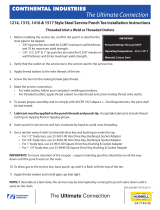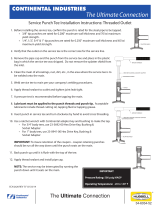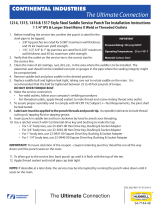Page is loading ...

The Ultimate Connection
CONTINENTAL INDUSTRIES
The Ultimate Connection
1201 & 1302 Style Steel Service Punch Tee Installation Instructions
Threaded Inlet x Compression Outlet for PE Pipe
1. Before installing the service tee, conrm the punch is rated for the
steel pipe to be tapped.
• 3/8" tip punches are rated for 0.280" maximum wall thickness
and 70 ksi maximum yield strength.
• 1/4", 1/2", 3/4" & 1" tip punches are rated for 0.250" maximum
wall thickness and 65 ksi maximum yield strength.
2. Verify that the compression outlet on the service tee is the correct
size for the polyethylene (PE) pipe. Verify the SDR (or wall thickness)
of the pipe matches the SDR (or wall thickness) stamped on the end of the stiener.
3. Apply thread sealant to inlet threads of the tee.
4. Screw the tee into the mating female pipe thread.
5. Make the service connection. See other side for outlet assembly instructions.
6. To assure proper assembly and to comply with 49 CFR 192 Subpart J—Test requirements, the joint shall
be leak tested.
7. Lubricant must be applied to the punch threads and punch tip. Acceptable lubricants include thread
cutting oil, tapping uid or tapping grease.
8. Insert punch in service tee and turn clockwise by hand to avoid cross threading.
9. Use a ratchet wrench with Continental drive key and bushing to make the tap.
• For 1/2" body tees, use 23-3691-00 Hex Drive Key, Bushing & Socket Adapter
• For 3/4" body tees, use 23-3692-00 Hex Drive Key, Bushing & Socket Adapter
IMPORTANT: To insure retention of the coupon - coupon retaining punches should be run all the way
down until the punch seats on the main.
10. To allow gas to the service line, back punch valve up until it protrudes 2 to 3 threads above top of tee.
11. Insert the hex drive of the O-ring plug cap into the socket of the punch valve and run the unit down until
it is leak tight. Take care as the threads of the O-ring plug cap engage the threads of the tee body to
prevent cross threading.
NOTE: If desirable at a later date, the service may be interrupted by running the punch valve down until
it seats on the main.
34-7144-12
IMPORTANT
For use on:
Polyethylene (PE) gas pipe meeting
the requirements of ASTM D 2513
Pressure Rating: Designed to meet or
exceed pressure rating of PE pipe per
49 CFR Part 192 and ASTM D 2513
Operating Temperature: -20 to 140° F
Material: Carbon Steel
ECN 2625 REV "E" 08/25/14

Compression Outlet for PE Pipe Installation Instructions
1. Install the compression nut and seal ring onto the outlet. Do not tighten the compression nut.
2. Cut polyethylene pipe end square, deburr inside and outside, clean thoroughly to assure there is no dirt,
grease, oil, etc. on assembly area of pipe.
3. Mark stab length on pipe (see examples for correct pipe or tubing size and corresponding stab length).
3/8" OD, 5/8" OD
7/ 8" OD, 1/2" IPS
1 11 /16" STAB LENGTH
1 1/ 8" OD, 3/4" IPS, 1” IPS
1 7/ 8" STAB LENGTH
4. Insert the polyethylene pipe through the compression nut until it bottoms in the outlet. (See detail "A")
5. Tighten compression nut until it bottoms on shoulder (metal to metal). (See detail "B") The stab length
line should be no more than 3/16" from face of the compression nut.
6. If the stab length line is more than 3/16" from the face of the compression nut, diassemble the joint and
repeat steps 1 through 5.
NOTE: It is advisable to limit shear at main connections. In this regard, your company's policies should be
followed. For further information, reference; ASTM D 2774 Standard Practice for Underground Installation
of Thermoplastic Pressure Piping; Code of Federal Regulations, Title 49, Transportation Part 192; AGA Plastic
Pipe Manual and/or The Guidance Manual for Operators of Small Gas Systems by the U.S. Department of
Transportation.
/












